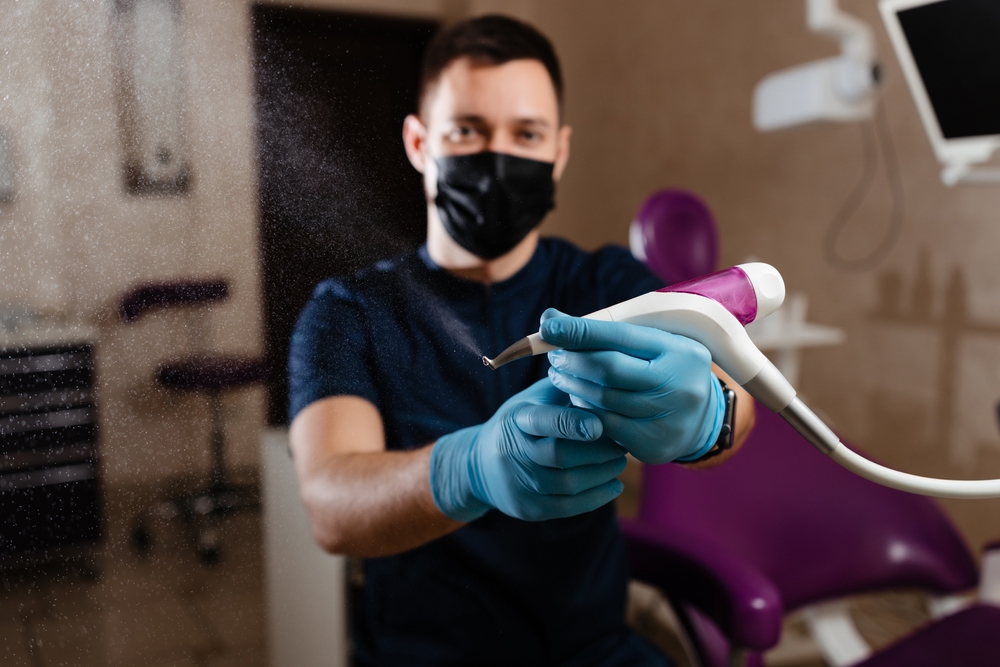
The airflow system is changing the standard for pain-free dental cleanings through guided biofilm therapy by integrating the use of powder, water, and pressurized air.
By Kayla Makowski, RDH
Airflow Prophylaxis Vs. Traditional Prophylaxis
The purpose of a dental cleaning is to remove biofilm on the tooth surface that bacteria attaches to, which causes plaque, calculus, stains, and caries. The most common biofilm removal method is through ultrasonic scaling, hand instrumentation, and rubber cup polishing. However, these methods can be time-consuming, especially for patients with heavy build-up.
The airflow was introduced as an innovative way to manage biofilm on supragingival and subgingival tooth surfaces effectively. All dental specialties can use this dental tool because of its versatility to be used on natural teeth, restorations, orthodontic appliances, and implants. A disclosing solution is placed to highlight areas of biofilm, and then an abrasive powder is sprayed onto the tooth surfaces. The fine particle powders allow the clinician to reach all the crevices to remove biofilm.
Studies have found the airflow to be more thoroughly clean while minimizing damage and reducing the time spent on biofilm removal compared to other methods - a two-in-one solution for cleaning and polishing.
What Is An Airflow Station?

The airflow station is a portable cart comprised of the following features:
- Airflow Max Handpiece
- Perioflow Handpiece
- Powder Capsule
- Pressurization Tower
- Pedal
The powder capsule houses the abrasive powder to be sprayed from the handpieces, and the pressurization tower creates the force for the stream. It also includes two handpieces, the airflow and perioflow handpieces.
The airflow handpiece is used only on supragingival tooth surfaces. However, the perioflow handpiece is intended for subgingival tooth surfaces and features a nozzle attachment with labeled measurements to reach pockets up to 9 millimeters. The clinician is in control of the station through the use of the pedal, which starts and stops the stream.
Types Of Airflow Powders
The most frequently used powders are as follows:
- Sodium Bicarbonate
- Glycine
- Erythritol
Sodium bicarbonate powder is a water-soluble powder used only on supragingival tooth surfaces due to its high level of abrasiveness and gingival irritation. It is recommended to avoid use on root surfaces and restorations because of damaging effects.
Glycine powder is a naturally occurring amino acid made of organic salt, which has a smaller particle size compared to sodium bicarbonate. For this reason, it is a gentler option to reduce irritation to the soft tissues and can be used both supragingival and subgingival.
Erythritol powder is an artificial sweetener with the smallest sized particles compared to sodium bicarbonate and glycine. Studies have shown it to be the most tolerable option for patients and can be applied supragingival and subgingival.
Airflow Use In Periodontal Disease Treatment
Periodontitis is a disease caused by plaque build-up, resulting in infection and irreversible damaging effects. Management of the disease requires patients to undergo treatments such as scaling and root planing followed by periodontal maintenance. These treatments can be uncomfortable and painful for the patient due to inflammation and sensitivity, therefore requiring local anesthetic and sedation upon request. However, the airflow provides a more comfortable treatment option through guided biofilm therapy, which eliminates the need for local anesthetic while still allowing the patient to be sedated if they choose. Research has shown air polishers to be safer, more efficient, and less painful compared to traditional methods. Additionally, erythritol powder has proven effective for periodontal treatment by reducing probing depths and bleeding on probing within twelve months.
Implementing The Airflow Into A Practice
Converting a practice to an airflow system requires a transition period. Some patients and providers may resist change, preferring traditional dental cleaning methods. Meanwhile, others may welcome the advancements in dentistry.
The airflow system offers many valuable benefits not only for the patients but also for the practice. Reduced time spent during cleanings allows for additional time for other areas of the appointment, such as oral hygiene recommendations, providing a more in-depth examination, and building rapport with the patient.
Time holds immense value for a dental practice, and allocating room for these alternatives can be highly beneficial. Providing education on the benefits of the airflow is key to making the transition as seamless as possible.
If you're not yet subscribed to receive the Incisor newsletter, filled with cutting-edge dental news sent directly to your inbox twice a month, you can do so here.
Author: Kayla Makowski is a Registered Dental Hygienist with a passion for providing education on the importance of oral health. Through continuing education courses, she is committed to staying up to date on the latest advancements in dentistry. Kayla finds joy in being a mom to her son. In her free time, you can find her spending time with family.




